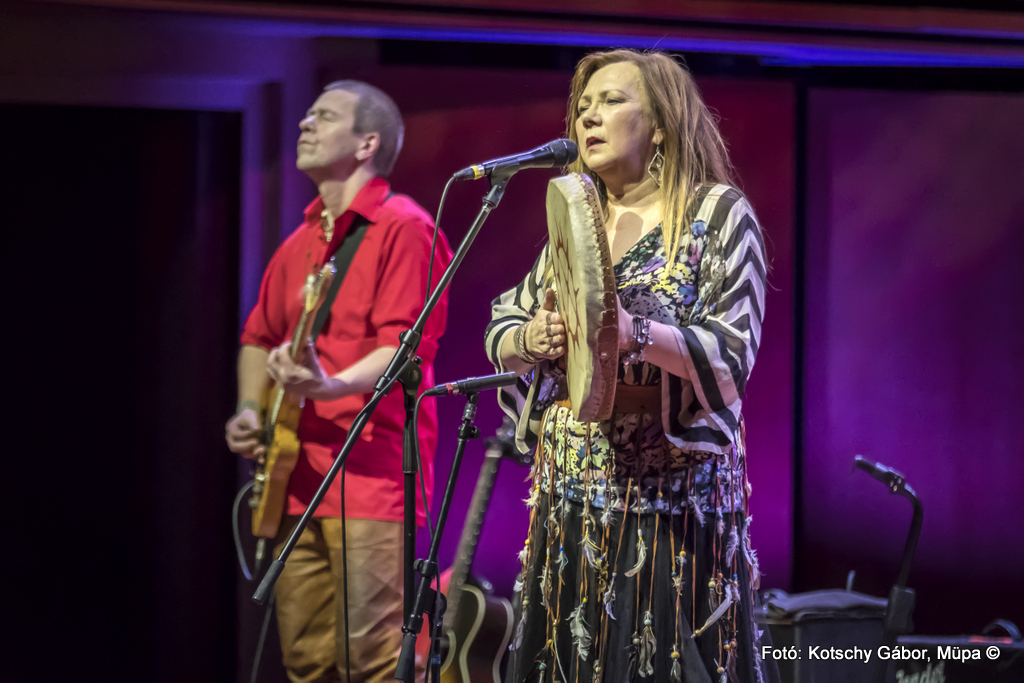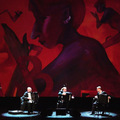The „Northern Light” is a title better, but less didactic, so no objections here. Just as we’re not objecting to anything about the double concert, as it went great, despite the fact that the two performers have had better shows here, in Hungary. But that one decade that went by without a single Värttinä or Mari Boine concert here caused such a longing that charged the atmosphere in the Béla Bartók concert hall to a near explosion. This happened despite the fact that we’re talking about two concerts with different characters: one is brash, often utilizing grandiose elements, the other reaches deep down to enchant us.
Just a few days after the centenary celebrations of the Finnish independence on 6th December, we were presented with a sort of bigger and clearer picture on the melting pot nature of the ethnic majority and minorities within the domain of music. One shouldn’t think that there has always been a unified and understanding attitude around, as regards Finnish culture, even the Finnish national identity has fought a long and strenuous battle to reach a celebrated level of dignity that we could all feel after the concerts. Few nations can say about themselves that the achievements of their slow revolution were aided by music, and finally the conflict-inducing diversity now calls an instance of historical retrospection a “virtue”, even in a modern state.
I first heard Värttinä live around 1996-97 at a world music festival in the nameless park in Óbuda, Budapest. They had already become famous by then with their album from 5 years before, titled “Oi dai”, and were on a tour to support their new album, “Kokko” (off which they sang the song, “Iro”). It was striking to see that not a complete choir of women –as I had imagined while listening to their albums- but only 4 girls were producing the band’s magnificent, strong, and solid vocal sound. Due to the Karelian connection, all different sorts of impressions, up from Estonia down to Georgia did and still come to mind today. Later, in 2000 they played at the Sziget festival and, not surprisingly, conjured a mighty atmosphere onto the stage, so they returned later too. I felt what they were doing was magical; and this spell is still being cast on their listeners through Värttinä’s visceral relationship to homophonic, or, rather syllabic vocals.
This singing style possesses a type of sacrament within itself, it is by no accident that we listeners associate this music with this quality, as we are close to the roots of mediaeval polyphony. Yes, one of the many wonders of world music is the circle of associations, when one may spiritually traverse centuries and countries and arrive in the present, noticing that after all, not that many things have changed. My earliest memories about Värttinä show a long, blond-haired girl with an accordion in hand, standing on the edge of the stage: today she is the lead singer, Susan Aho. Mari Kaasinen remained from the original founding members, Karoline Kantelinen on the other hand is a recent addition to the band; the most recent incarnation of the band only includes the three of them. While all bands undergo development, Värttinä, however, appears to have made a step back as regards instrumental background music. Their past setup is largely missing, they are smaller in apparatus, and this has resulted in a decrease in the quality of musical formation. The girls still sing with burning ambition, and this allows, or even calls for an inclusion of a more mundane style into their highly-trained vocals. The concert ended on the high note of the a cappella song to which, despite my comment on the smaller apparatus, the musicians provided a beautiful instrumental background.
Mari Boine brings her notes from up north, over the polar circle, while her dark and wind-strewn music’s foundations may allude to modern underground influences too. The sound of the synthesizer and other electronic instruments, the drummer’s unique, low-tuned tom and snare-less, almost whispering play, and the key role of the vocalist-rhythm guitarist held the ancients by their hands in a way that the audience could still see into the future that the band put on the stage. Or maybe the great enchantress’ ageless, enigmatic aura let no-one ponder too long. She said she has been making albums for a good 30 years and has always sung in Saami, but now produced an album in English. In contrast, as if the spell had been broken with a loud crack, the English language, and the shift towards pop music simply somehow does not fit in with Boine’s earlier work; apparently, to become the medium of the great northern spirit, one must be singing in Saami.
In her hands, even the shamanic drum sounds credible; her music is not a commercial product, but an emblematic manifestation of a nation’s culture that once lived under oppression, but transgressed its own borders. Mari Boine became a national hero without any association of pathos to her work. She teaches all generations about humility, faith, endurance, and identity.
Északi fény: Värttinä és Mari Boine kettős koncert - Müpa, december 18.)
Ha tetszett a cikk, kövesd a blogot itt és oszd meg ismerőseiddel is. Kösz!
Translated by Kálmán Farkas
A bejegyzés trackback címe:
Kommentek:
A hozzászólások a vonatkozó jogszabályok értelmében felhasználói tartalomnak minősülnek, értük a szolgáltatás technikai üzemeltetője semmilyen felelősséget nem vállal, azokat nem ellenőrzi. Kifogás esetén forduljon a blog szerkesztőjéhez. Részletek a Felhasználási feltételekben és az adatvédelmi tájékoztatóban.






